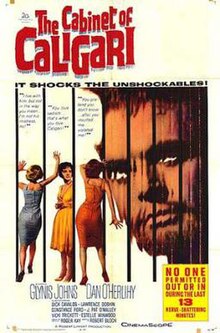Loading AI tools
1962 American horror film From Wikipedia, the free encyclopedia
The Cabinet of Caligari (also known as The Cabinet of Doctor Caligari) is a 1962 American horror film directed by Roger Kay, starring Glynis Johns, Dan O'Herlihy, and Richard Davalos, and released by 20th Century Fox.[2]
| The Cabinet of Caligari | |
|---|---|
 Theatrical release poster | |
| Directed by | Roger Kay |
| Written by | Robert Bloch |
| Produced by | Roger Kay |
| Starring | |
| Cinematography | John L. Russell |
| Edited by | Archie Marshek |
| Music by | Gerald Fried |
| Distributed by | |
Release date |
|
Running time | 105 min. |
| Countries |
|
| Language | English |
| Budget | $1 million[1] |
Although the film's title is very similar to the German silent horror film The Cabinet of Dr. Caligari (1920), it shares very few similarities except for the main plot twist. The film's script was written by Robert Bloch, author of the novel Psycho. The cinematographer for The Cabinet of Caligari was John L. Russell, who also worked on Alfred Hitchcock's film Psycho (1960).
Motorist Jane Lindstrom has a tire blowout and seeks assistance at an estate owned by Caligari, a very polite man with a Swedish accent. After spending the night there, she finds that Caligari will not let her leave; he proceeds to ask some personal questions and shows her pictures that offend her.
Prevented by guards from leaving and unable to use the telephone, Jane seeks allies among the other guests. She finds only three possible candidates: the older Paul, the younger Mark, for whom she has romantic desires, and a lively elderly woman named Ruth. After seeing Ruth tortured, Jane goes to Paul who convinces her to confront Caligari. Jane does so and tries to seduce him, as she suspects he has been spying on her in the bath. After her attempts fail, Caligari reveals that he and Paul are one and the same person, Jane runs down a corridor of wildly shifting imagery that acts as a transition.
Finally, it is revealed that Jane is a mental patient and everything the audience has seen up to this point has been her distortion of the institute she was in: the personal questions were psychoanalysis, the pictures were Rorschach blots, Ruth's torture was shock treatment, and even Caligari's coat of arms was a distorted version of the medical caduceus symbol. Cured, Jane is taken from the asylum by Mark, now revealed to be her son.
Sam Goldwyn bought the remake rights in 1921.[1] He assigned the project to French-born Roger Kay, who had directed Grand Guignol theatre in Paris and New York. He also had degrees in psychology.[3] The director Roger Kay persuaded Robert Bloch "to drop the Dr from the original title but do a story with enough similarity to be recognizable as an homage."[4] At one stage, the film was just known as Caligari.[5] The story of the way director Roger Kay tried to rob Bloch of the writing credit for the film and how Bloch won is told in Bloch's autobiography.[6]
Robert Lippert's movies around this time normally cost $500,000, but Lippert allowed extra funds for this movie. It was shot over 25 days.[1] Harry Spalding, who worked for Lippert, later recalled that everyone in their organization thought making the film was a bad idea except for Lippert. He says the director hired Robert Bloch to write the script, but they had a falling out and the director wrote the script himself.[7] Bloch's signing was announced in July 1961.[8] Glynis Johns was signed in November.[9] Maury Dexter, head of Lippert's company, says Lippert told him "to give Roger [Kay] a wide berth because he expected great things from him."[10]
Kay used a colour chart when making the film. He went through the script and allocated a colour representing the emotion the audience was to feel.[1]" The new Caligari is completely modern", said Kay during filming. "I don't want to sound presumptuous but I am trying to get the Pirandello approach that says nothing is what it appears to be. The thesis behind the damsel in distress, behind the little thrills and shocks is, What is reality?"[1]"This picture is going to cause a lot of talk", said Lippert.[1] Dexter says once he read the script and saw how different the film would be from the original, he advised Lippert to fire Kay, but Lippert backed the director. He also says Kay yelled at Glynis Johns during filming and Johns ran off the set; Lippert forced Kay to apologize so filming could continue.[10]
According to Dexter, the film was a critical and financial failure.[10]
In 1963, Kay said he "disowns" the film, blaming Fox for turning it into a "lurid, sex charged picture" and claiming the version released was "considerably different" from his version. He said a copy of his original cut was with the Museum of Modern Art.[11]
Lippert wanted to reunite O'Herlihy and Johns in an adaptation of Trilby,[12] but no film resulted.
Seamless Wikipedia browsing. On steroids.
Every time you click a link to Wikipedia, Wiktionary or Wikiquote in your browser's search results, it will show the modern Wikiwand interface.
Wikiwand extension is a five stars, simple, with minimum permission required to keep your browsing private, safe and transparent.